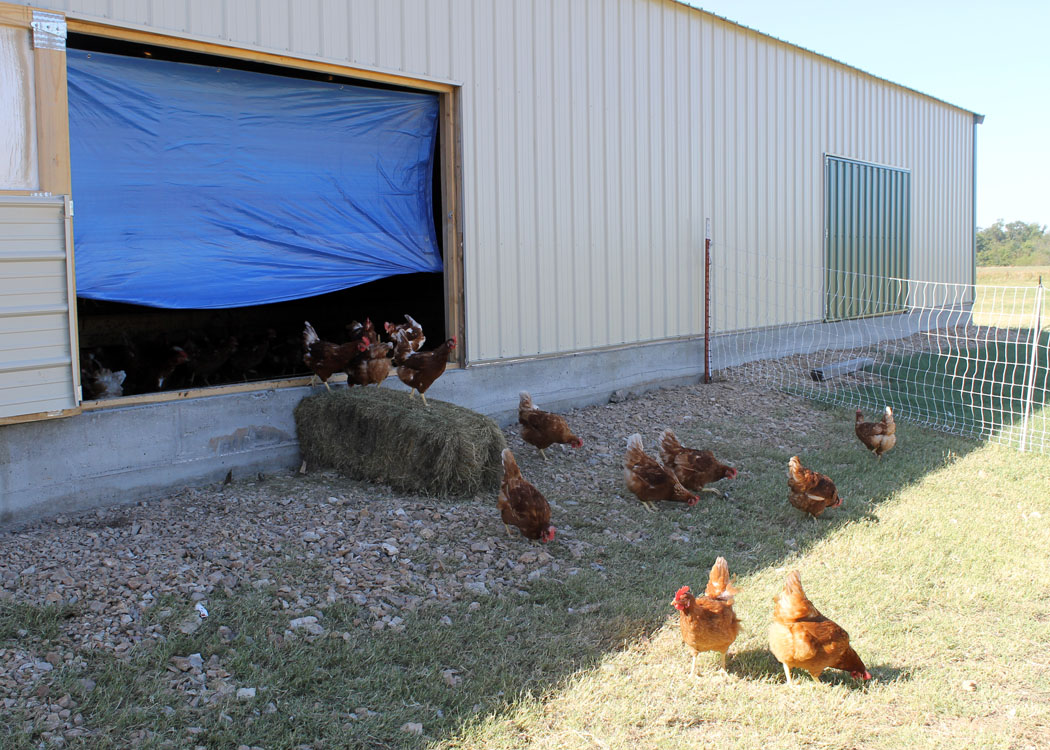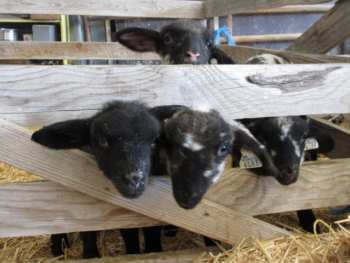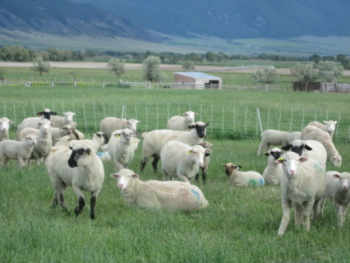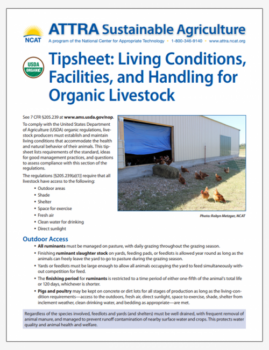Tipsheet: Living Conditions, Facilities, and Handling for Organic Livestock

Photo: Robyn Metzger, NCAT
By Linda Coffey, NCAT Agriculture Specialist
See 7 CFR §205.239 of the Code of Federal Regulations.
To comply with the U.S. Department of Agriculture (USDA) organic regulations, livestock producers must establish and maintain living conditions that accommodate the health and natural behavior of their animals. This tipsheet lists requirements of the standard, ideas for good management practices, and questions to assess compliance with this section of the regulations.
The regulations [§205.239(a)(1)] require that all livestock have access to the following:
- Outdoor areas
- Shade
- Shelter
- Space for exercise
- Fresh air
- Clean water for drinking
- Direct sunlight
Outdoor Access
- All ruminants must be managed on pasture, with daily grazing throughout the grazing season.
- Finishing ruminant slaughter stock on yards, feeding pads, or feedlots is allowed year round as long as the animals can freely leave the yard to go to pasture during the grazing season.
- Yards or feedlots must be large enough to allow all animals occupying the yard to feed simultaneously without competition for feed.
- The finishing period for ruminants is restricted to a time period of either one-fifth of the animal’s total life or 120 days, whichever is shorter.
- Pigs and poultry may be kept on concrete or dirt lots for all stages of production as long as the living-condition requirements—access to the outdoors, fresh air, direct sunlight, space to exercise, shade, shelter from inclement weather, clean drinking water, and bedding as appropriate—are met.
Regardless of the species involved, feedlots and yards (and shelters) must be well drained, with frequent removal of animal manure, and managed to prevent runoff contamination of nearby surface water and crops. This protects water quality and animal health and welfare.
Temporary Confinement
Livestock may be confined for a short time for the following reasons:
- Inclement weather
- Specific health and safety needs of the animal
- Risk to soil or water quality
- The animal’s stage of life
Communicate with your certifier about any plans you have to restrict your livestock’s outdoor access. Be certain to outline your rationale in detail within your Organic System Plan (OSP).
“Stage of life” refers to a period of time in an animal’s life (e.g., baby chicks, fully feathered chicks, pullets, and laying hens or baby pigs, feeder pigs, and fattening pigs). Different stages of life bring different needs, and that is acknowledged in the USDA organic regulations. Lactation is not a “stage of life” that allows confinement.

Photo: Maggie Clark
Shelter
The regulations call for the provision of shelter that allows animals:
- Opportunity to exercise
- Protection from temperature extremes
- Adequate ventilation and air circulation
- Comfort behaviors
- Natural grooming and maintenance
- A low-hazard environment to prevent injury
- Bedding as appropriate to the species (Roughage used, such as straw or crop stubbles, must be organic.)
Wooden Structures/Treated Lumber
Regarding the wooden structures used in organic production facilities, here is what the regulations say:
- In instances where conventional operations are being converted to organic production, treated wood may be permitted if it does not represent a significant contamination hazard to animals or feed.
- New or replacement construction may not contain any prohibited materials—such as arsenate-treated wood, lead-based paints, creosote, etc.—where they can contact organic soil, crops or animals.
For more information on this subject, see the ATTRA publication, Pressure-Treated Wood: Organic and Natural Alternatives.
Structural Pest Management
Structural pests include a wide range of organisms such as termites, which can damage structures; mice and grain weevils, which use structures as habitat and a food source; and mites and lice, which exploit the structural environment to infect or infest a host animal. As with weed, pest, and disease management, you are required to use a multilevel, hierarchical approach. Begin with preventive measures (Level A) and then, as needed, progress to Level B (physical and mechanical controls). If those measures are not sufficient, Level C is the third line of defense, in which you may use the non-synthetic and allowed synthetics provided for on the National List of Allowed and Prohibited Substances.
Remember that any materials used must first be approved by your certifier and then listed in your OSP.

Photo: Dave Scott. NCAT
Low-Stress Handling
Unnecessary stress reduces productivity, increases susceptibility to disease, reduces meat quality, and increases the likelihood of injury to both animals and humans. The livestock health care practice standard (§205.238) stipulates that the producer must provide conditions which allow for reduction of stress appropriate to the species. Commonsense measures that will comply with this part of the regulation include:
- Keep animals well-nourished
- Provide adequate space for exercise
- Furnish shelter appropriate to the climate and weather, and keep it sanitary and safe (remove hazards that may injure animals)
- Allow animals to have companions, except in case of contagious illness
- Provide comfort measures for the season; bedding, warm water, windbreaks, lots of good-quality roughage and more feed in winter; cool, clean water, extra space, air movement, misters or wallow for hogs in summer.
- Practice good sanitation (shelters, feedyards, feed troughs, water tanks)
- Use calm, quiet handling when moving, loading, performing routine chores and health care
Questions
- Are all your livestock given access to the outdoors, fresh air, sunlight, space to exercise, and shelter from inclement weather?
- Are all your livestock provided with sufficient quantity and quality of feed and water to meet their health and welfare needs?
- Are all your ruminant stock provided with pasture?
- Do your animals on pasture or range have access to some form of protection from severe weather?
- Are all wooden livestock buildings, corrals, handling facilities, fence posts, gateposts, board fencing, etc. constructed either with untreated wood or with other allowed materials?
- Do you use allowed materials and processes to control structural pests in livestock-production buildings?
- Do you provide adequate bedding for temporarily confined and semi-confined livestock when and where needed? Note that in circumstances where roughages are used for bedding, the bedding materials must be certified organic.
- Do you store prohibited materials where they pose no danger of contamination to livestock?
- Is housing cleaned and manure removed often enough to protect livestock health?
- Are you managing manure and pastures in a way that protects soil and water quality and optimizes recycling of nutrients?
- Do you use only allowed materials to clean and sanitize housing units?
- Are your production buildings and areas adequately protected from pesticide drift and/or infiltration by contaminated runoff water?
- If you produce organic and conventional animals, do you segregate the animals or use some form of identification to ensure that only organic animals are sold as organic?
- Do you use organically approved methods and materials to manage weeds around facilities and buildings? Allowed practices and materials typically include but are not limited to the following:
- Thermal weeding (i.e., flaming)
- Grazing
- Hoeing or pulling by hand
- Mowing/string trimming
- Using herbicidal soaps and/or other allowed substances
- Are your buildings and production lots numbered and records maintained that document management history?
- Does your Organic System Plan fully list all materials and procedures used to manage organic livestock and preserve organic integrity?
Resources
National Organic Program Handbook
Tipsheet: Livestock Living Conditions, Facilities, and Handling
By Linda Coffey, NCAT Agriculture Specialist
Published July 2015
© NCAT
IP506 Slot 519
This publication is produced by the National Center for Appropriate Technology through the ATTRA Sustainable Agriculture program, under a cooperative agreement with USDA Rural Development. This publication was also made possible in part with funding from U.S. Department of Agriculture’s Agricultural Marketing Service, National Organic Program. ATTRA.NCAT.ORG.


